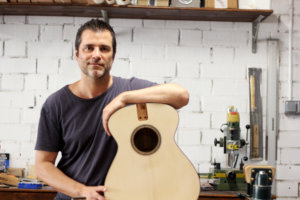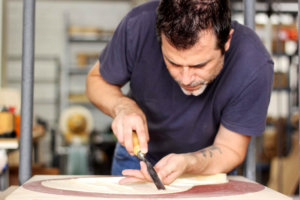
My name is David Solé and I’m the one behind Leno Guitars. The amount of passion and enthusiasm that I put in building a guitar is something hard to describe. Since I was a little boy guitars have been around so it felt natural to me to start building them. The moment I got in touch with lutherie I knew I wanted to do that for the rest of my life.
I still remember the day I entered Steve’s workshop. He asked me what I wanted to build and I couldn’t get my eyes out of an acoustic guitar mould with some rosewood sides bent on it. That’s how it all began. I spent four and a half years with Steve Higgins learning the foundations on making acoustic guitars. After that I quitted my job as a Civil Engineer and decided I wanted to become a professional Luthier. I went to the Irish School of Lutherie in Galway and learned how to make resonators, maccaferri style guitars and ukuleles. Those days were hard, intense and rewarding at the same time. Understanding in guitar making grew and I felt prepared to make my own designs.
Nowadays, I spend all of my time making acoustic guitars and my love for it and my aim to become a better luthier probably will take to different places with different people so I can learn different techniques and processes so my guitars can improve in every way.
In the meanwhile you can find me making the best possible acoustic guitars in my workshop where you are invited anytime.

Philosophy
My aim is to build an instrument that feels natural to the player. Responsive and articulate but complex and colourful at the same time.
Making a guitar involves many processes and different techniques. I focus in four big concepts when designing and building acoustic guitars: Aesthetics, Playability, Construction and Sound.
I like to create my own designs and even though I know that they are inspired in older models I know that there’s no other guitar equal to mine in terms of shape. I like to work with all kind of woods but I kind of favour Rosewood, Walnut and Mahoganny for back and sides, Spruce for the tops and Spanish Cedar and Ebony for necks and fingerboards. This together with the use of Satin finish on the body paired with the hardwax Oil on necks makes my main aesthetic choice. High Gloss with Nitrocellulose and French polish are finishes that I also offer as an option.
Ergonomics and playability play an important role when creating a Guitar. As a Player myself I know how important is to feel comfortable with your instrument. I like to call my guitar custom as they are made to specs from the customer. To adapt the instrument to the player needs is a part of the luthier role and I pay close attention to what the player says. Scale length, fretboard radius, nut width, bridge spacing, neck shape, neck thickness, and set up are some of the things I accommodate to the musician so that the guitar feels like an extension to the player.
I like to think that every guitar out of the workshop is different and better from the last one in terms of sound but also in terms of construction. Nowadays many new techniques are used in guitar making. I like to incorporate many of this new advanced features to achieve the best guitar that last for years. Some of the features present in my guitars are: a complete bolt on neck joint, laminate sides and laminate linings, reinforced neck with titanium or carbon fiber, floating bar on the back braces and many others. I may not use all of them at the same time because they all play a role in the final result but mixed with older techniques are the way I make guitars.
SHAPING THE SOUND
My background as an engineer makes me question almost everything and that’s why from the very beginning I tried to understand the physics behind sound production. Building a guitar following a plan may be a good idea at first but once you’ve done a couple of guitars you start to think about certain things: bracing patterns, top and back thickness, laminated sides, heights of braces, etc. With every change you are altering the way the guitar behaves. Physical properties of materials, even within the same species, adds more variables to the equation and even harder to find the good receipt. One end up understanding that there’s no unaltered solution to get a certain sound. Characterizing of the sound produced by your guitar is the way to go and that’s what I call Shaping the sound.
Besides tapping, flexing and listening to every wood part, my building method includes the measurement of acoustical properties and frequency responses through the process of making the instrument. This allows me not to work with specific dimensions but to achieve certain frequencies that are related with how the whole system behaves. This led to consistency in sound and also to anticipate the results of altering heights and thicknesses of every guitar part.
